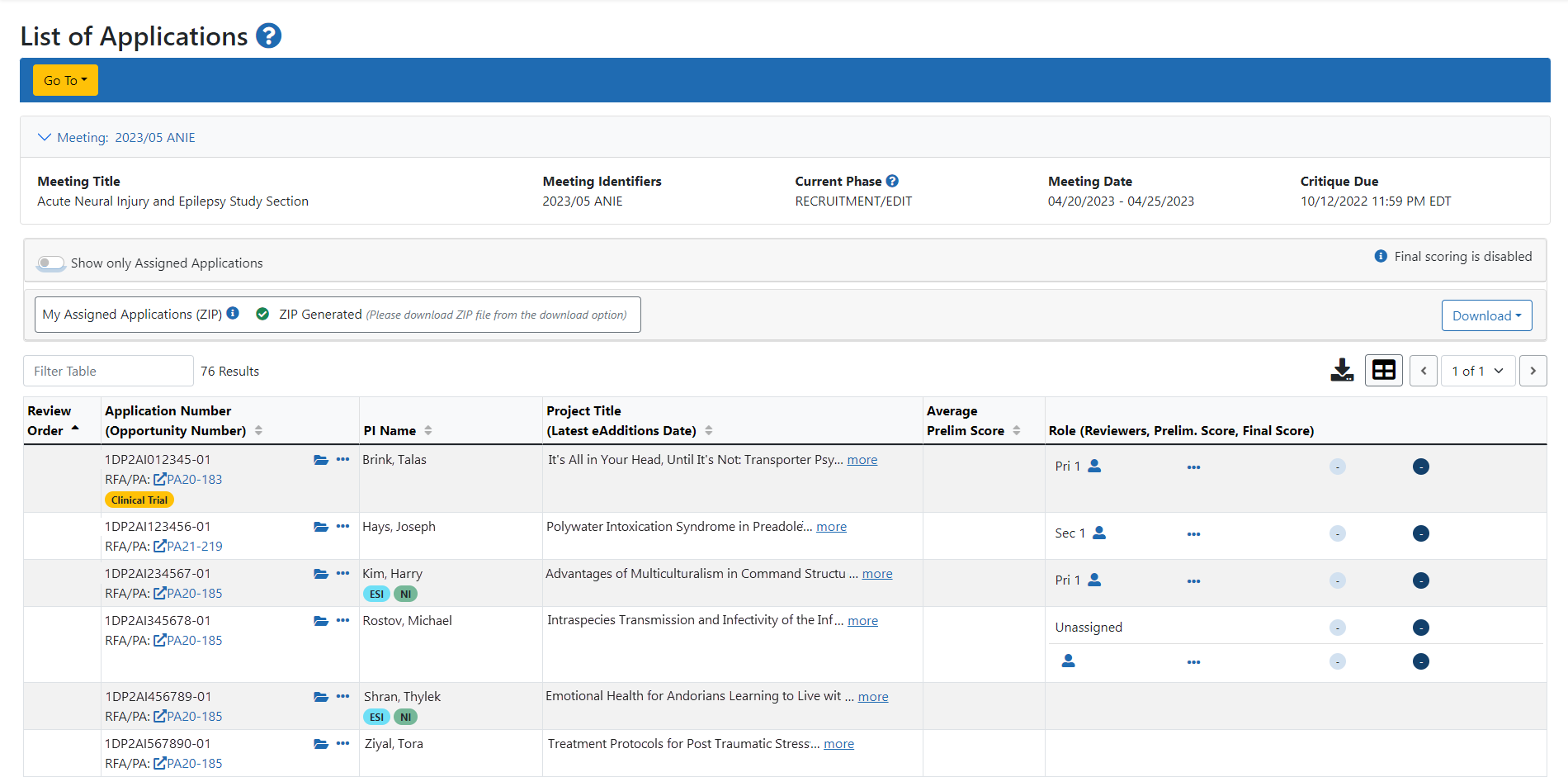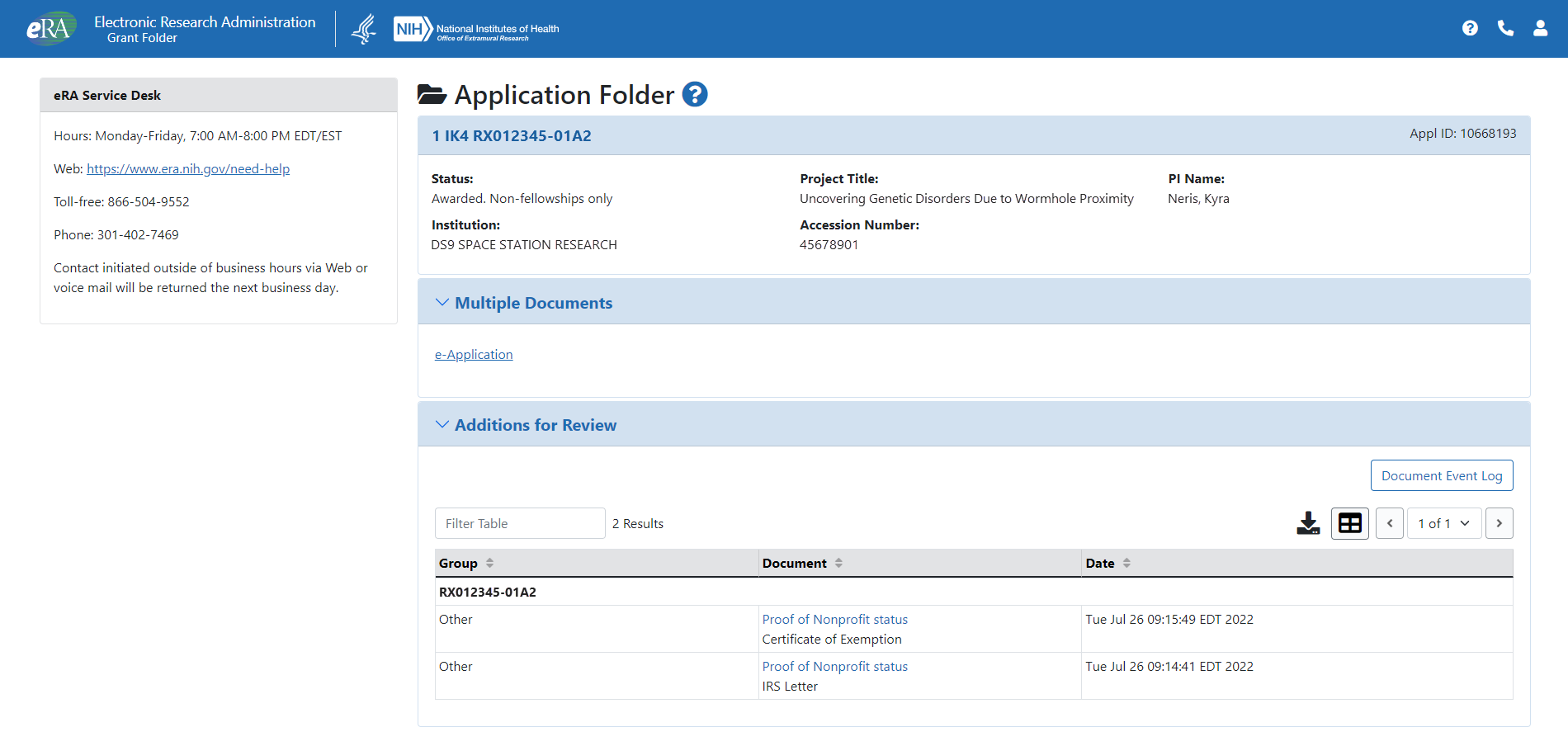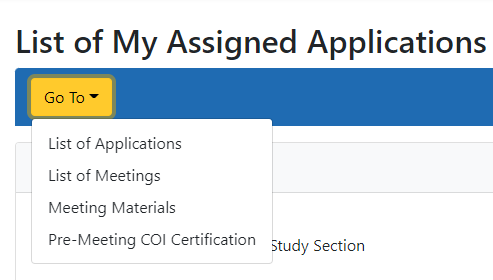Accessing the List of Applications Screen
To access the List of Applications after signing the confidentiality agreement (Refer to Confidentiality Agreement):
-
Log into eRA Commons and select the Internet Assisted Review button on the
 landing page.
landing page.You can also access IAR from the apps icon in the upper left corner and selecting Internet Assisted Review from the
 drop-down menu.
drop-down menu. The List of Meetings screen displays. If accessible, the View List of Applications link is displayed by clicking on the three-dot ellipses icon.
-
 Select the View List of Applications link.
Select the View List of Applications link.
By default, the List of My Assigned Applications is displayed. However, in later phases of the meeting, IAR provides access via this screen for viewing all applications in the meeting if the SRO* has opened the meeting for unassigned critiques. ![]() click to view the List of My Assigned Applications screen)
click to view the List of My Assigned Applications screen)
To view all applications in the meeting, click the "Show only Assigned Applications" switch to the off position. .
NOTE: Mail reviewers are only able to see applications to which they are assigned and can only view their own critiques.
Both views display information for the applications in the meeting. The meeting title, identifier, and phase as well as meeting dates and critique dates display above the list of applications.
Below this information are links for List of Meetings, View Meeting Materials, and links for viewing critiques, which vary from phase to phase.
The table displayed on the screen is the List of My Assigned Applications. This list includes columns of information for Review Order; Application Number (Opportunity Number) (including the application number and RFA/PA associated with the application), and include Clinical Trial (CT), Clinical Trial Research Experience (CTRE), and Human Fetal Tissue (HFT) indicators; PI Name (parent application PI), which includes Early Stage Investigator (ESI) indicator and New Investigator (NI) indicator; the Project Title of the application; Average Prelim Score (the average preliminary score for the application); Role of the reviewer; Reviewer (name); Prelim. Score; the Final Score of critiques; and the available action options for the reviewer are available by clicking the three-dot ellipses icon.
The information in the table can be sorted by any column that has a gray triangle icon after the column name (![]() ). A black triangle icon (
). A black triangle icon (![]() ) next to the column name indicates the current sort. The triangle pointing up is ascending. The triangle pointing down is descending.
) next to the column name indicates the current sort. The triangle pointing up is ascending. The triangle pointing down is descending.
![]() Click here for an image of the List of Applications default view.
Click here for an image of the List of Applications default view.
The Application Number (Opportunity Number) column includes a folder icon (![]() ). Clicking the icon opens the application
). Clicking the icon opens the application![]() Application Folder, from which several other options are available for viewing including the e-application, prior summary statements (if existing), and any e-additions that have been added for the application.
Application Folder, from which several other options are available for viewing including the e-application, prior summary statements (if existing), and any e-additions that have been added for the application.
Action options found by clicking the three-dot ellipses icon are phase dependent and include Review Criteria, Critique Template, Submit Critique, View Critique, and Delete Critique depending on whether a reviewer is allowed to submit or has already submitted a critique.
The Submitted Date column shows the latest date when the critique for an application was (re)submitted.
The Assignment Role for an application displays COI if the reviewer has a conflict of interest with personnel of the application. Links for submitting, viewing, and deleting critiques are not displayed for these applications. In addition, the existence of a specific type of conflict (CD Conflict) will suppress the link to the application’s Application Folder.
The List of Applications screen (among others) provides access to the tools necessary for completing tasks in each phase. As such, the look and functionality of this screen may vary depending on a reviewer’s role and the current meeting phase.
Global Navigation
A![]() global navigation menu is present on the following screens: List of Applications, List of Meetings, Meeting Materials, and Preliminary Score Matrix. This may change dependent upon the user's role.
global navigation menu is present on the following screens: List of Applications, List of Meetings, Meeting Materials, and Preliminary Score Matrix. This may change dependent upon the user's role.
- List of Applications
- Updates the screen to show all the applications in the meeting, regardless of the current reviewer’s assignments. This is not available for Mail reviewers and reviewers blocked by the SRO from viewing others’ critiques before submitting their own. The orange triangle icon next to the link indicates that this is the current view.
- List of Meetings
- Returns the user to the List of Meetings screen.
- Meeting Materials
- An SRO can provide reviewers with links and documents containing relevant information for the review meeting. If the SRO has provided materials, they are accessible through this link.
- Preliminary Score Matrix
- The Preliminary Score Matrix screen option is only visible in Read phase. It allows a reviewer to see the preliminary overall/impact scores assigned by other reviewers for all applications in which the reviewer is not in conflict.
Each page includes a number of links specific to that page.
The other links include links to critiques, critique templates, and application options:
View Critique Options
- View My Critiques
- Opens a PDF document containing all of a reviewer’s preliminary critiques and scores.
- View Critiques by:
- Opens critiques by Application, PI name, All the Reviewers' critiques and by Assigned Applications.
- Download a Zip of My Assigned Critique Templates
- (Does not appear for online critiques) Downloads a compressed file containing all of the critique templates associated with the applications assigned to you. When the file is extracted, the individual templates will follow this naming convention:
- [PI name]_[application number]_[reviewer role]
- e.g. Smith_1R01123456-01_Pri_4.docx. )If a reviewer has no assigned role, that part of the file name will be dropped.)
- (Does not appear for online critiques) Downloads a compressed file containing all of the critique templates associated with the applications assigned to you. When the file is extracted, the individual templates will follow this naming convention:
- List Applications Options (Submit Phase) or List My Assignments Only (Read and Edit Phases)
- Updates the screen to show only: List all Applications, or the applications assigned to the reviewer. This is the default view of the screen. .
Column Headings
The column headings bar contains functionality, including:
- Where headings are underlined, this indicates that they can be sorted.
- If they contain orange triangle icons, this indicates this is the current view.
- The Collapse All heading
![]() The Additional Materials link displays within the Title column (beneath the application title) if the application has at least one eAddition in its Application Folder.
The Additional Materials link displays within the Title column (beneath the application title) if the application has at least one eAddition in its Application Folder. ![]() The link opens the Additions for Review section of the Application Folder.
The link opens the Additions for Review section of the Application Folder.
TIP: To keep track of any additional material added without checking back every time, simply look for the date displayed within the link. This represents the Latest eAdditions Date.
Final Score Sheet (button)
Opens the Final Score Sheet for entering final impact scores as well as criterion scores. This button is only enabled during the period of final scoring as entered by the SRO in IAR and may not be applicable to all meetings. The button is visible but disabled outside of final scoring or if final scoring is not used for a meeting.
NOTE: The Final Score Sheet button does not display on your List of All Applications if you are a Mail reviewer.
TIP: *Other Transaction Authority (OTA) - Some screens and terminology may be different in order to accommodate review of OTA, a type of award that is neither a grant nor a contract but a different way of funding that is used across NIH. These changes will typically not be visible to NIH or agency reviewers.









